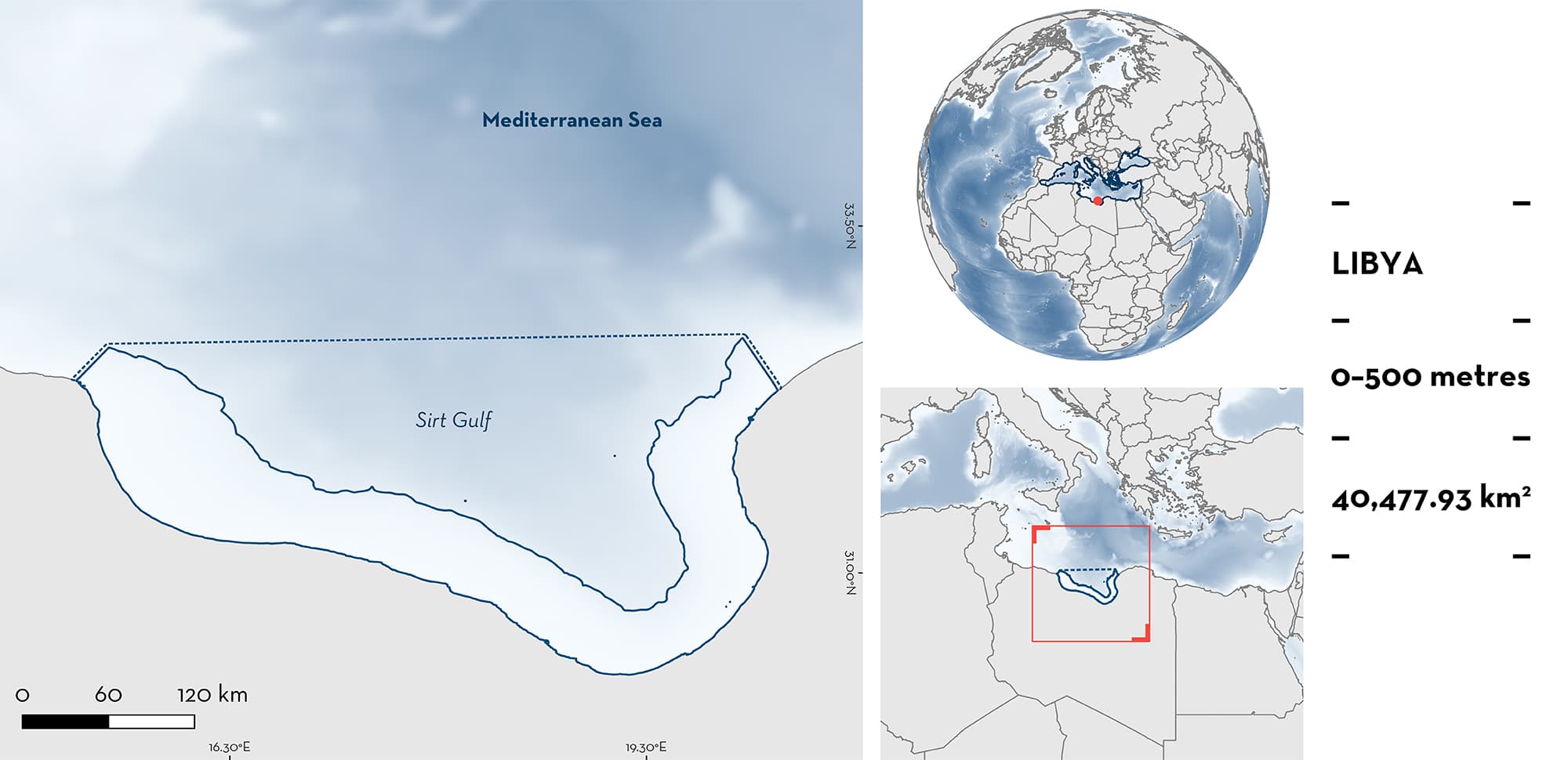ISRA FACTSHEETS
ISRA FACTSHEETS
MEDITERRANEAN AND BLACK SEAS REGION
Sirt Gulf
Summary
Sirt Gulf lies along the coast of Libya in the southern Mediterranean Sea. The area is characterised by sandy bays interspersed with small rocky areas, and seagrass beds. It is bordered by salt marshes and terrestrial coastal protected areas. Sirt Gulf is known as a hotspot for biodiversity and contains five Key Biodiversity Areas and overlaps with an Ecologically or Biologically Significant Marine Area. Within this area there are: threatened species (e.g., Smoothback Angelshark Squatina oculata); and important reproductive areas (e.g., Angelshark Squatina squatina).
Download factsheet
Sirt Gulf
DESCRIPTION OF HABITAT
Sirt Gulf is a large coastal area in Libya in the southern Mediterranean Sea. The area is characterised by sandy habitats, but also includes seagrass meadows, photophylous algae, rocky substrates, detrital substrates, and cliffs along the coast (Hamza et al. 2011). The shallow areas of the gulf reach 30ºC in the boreal summer, and salinity is relatively high (38–39), due to the arid climate resulting in high evaporation rates and low freshwater input.
The area overlaps with five Key Biodiversity Areas (Tawuoryhe Sebkha, Gulf of Sirte, Geziret Garah, Benghazi, and Jabal al Akhdar) (KBA 2023), and the Gulf of Sirte Ecologically or Biologically Significant Marine Area (EBSA) (CBD 2023).
This Important Shark and Ray Area is benthic and is delineated from inshore waters (0 m) to 500 m depth based on the maximum depth range of the Qualifying Species and the bathymetry of the area.
CRITERION A
VULNERABILITY
Two Qualifying Species considered threatened with extinction according to the IUCN Red List of Threatened SpeciesTM regularly occur in the area. These are the Critically Endangered Smoothback Angelshark (Morey et al. 2019a) and Angelshark (Morey et al. 2019b).
CRITERION C
SUB-CRITERION C1 – REPRODUCTIVE AREAS
Sirt Gulf is an important reproductive area for two shark species.
Among few other areas in the Mediterranean Sea, the coastal waters of Libya, and in particular Sirt Gulf, was recently identified as an important area for angel sharks (Al-Mabruk et al. 2019; Giovos et al. 2019). Between 2020–2021, angel shark individuals were recorded along the Libyan coastline during nearly every landing survey conducted in ports and fish markets of major coastal cities. Most sharks were captured in trammel nets and trawls. Data were also collected based on fisher sightings as part of regular surveys and interview questionnaires conducted by the Angel Shark Project: Libya (S. Al-Mabruk unpubl. data 2023).
In total, 54 Smoothback Angelshark were recorded. Of these, 52% (n = 28) were confirmed within the Sirt Gulf, while the remaining individuals (n = 26) were scattered along the rest of the Libyan coast (i.e., east and west of Sirt Gulf). Most records were from the months of December to February. All life stages were regularly recorded, including five juveniles ranging from 50–60 cm total length (TL) (S. Al Mabruk unpubl. data 2023). Size-at-birth for the species is 23–27 cm TL (Capapé et al. 2002). These records of juvenile sharks suggest that they may be using the area as a nursery area until they reach a larger size. A similar observation has been reported from the Canary Islands, where nursery areas for the Angelshark have been confirmed, based on juveniles using areas for at least a year until they reach a similar size and leave the area (Jimenez-Alvarado et al. 2020; Meyers et al. in prep). Of all recorded and sexed individuals, 46% were females at various life stages. This species is known to undertake inshore-offshore migrations as part of its reproductive cycle. Thus, individuals at different life stages may be using the shallower areas of the Sirt Gulf to reproduce and then move back into the deeper areas. Moreover, one adult pregnant female was recorded aborting pups after capture
and landing in Misrata port. Juvenile sharks were recorded near the coastal waters of Sirt City, indicating that, similar to other parts of the range, these shallow coastal areas are likely used as breeding and as potential nursery areas (Meyers et al. 2017).
Nine individuals of the Angelshark were recorded from surveys, five of which were females. Three sharks were adults and six subadults. In addition to these nine sharks, two pregnant females, one captured near Sirt city, were captured carrying pups which were aborted onboard fishing vessels. Moreover, a young-of-the-year (YOY) was accidentally captured in the shallow coastal area near Sirt. In addition to the information gathered during the landing and market surveys, citizen science data was collected via social media channels and verified by the Angel Shark Project: Libya. A total of 55 records of Angelshark were submitted. All records were either of dead or captured individuals within the Sirt Gulf by trawls, spearfishing, and trammel nets. These records include all size classes, including two dead YOY and one pregnant female with aborted pups (S. Al-Mabruk unpubl. data 2023).
Download factsheet
SUBMIT A REQUEST
ISRA SPATIAL LAYER REQUEST
To make a request to download the ISRA Layer in either a GIS compatible Shapefile (.shp) or Google Earth compatible Keyhole Markup Language Zipped file (.kmz) please complete the following form. We will review your request and send the download details to you. We will endeavor to send you the requested files as soon as we can. However, please note that this is not an automated process, and before requests are responded to, they undergo internal review and authorization. As such, requests normally take 5–10 working days to process.
Should you have questions about the data or process, please do not hesitate to contact us.


